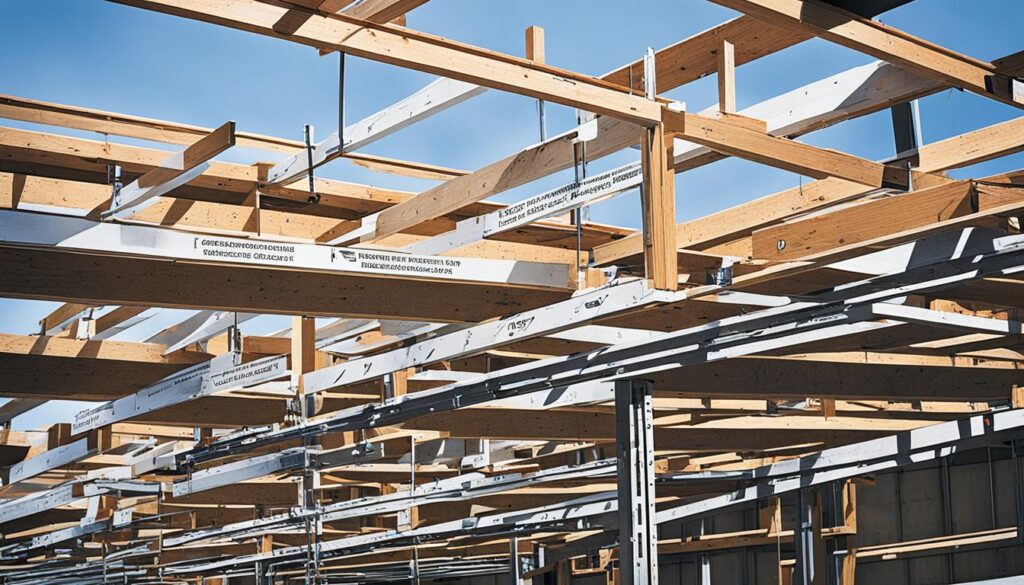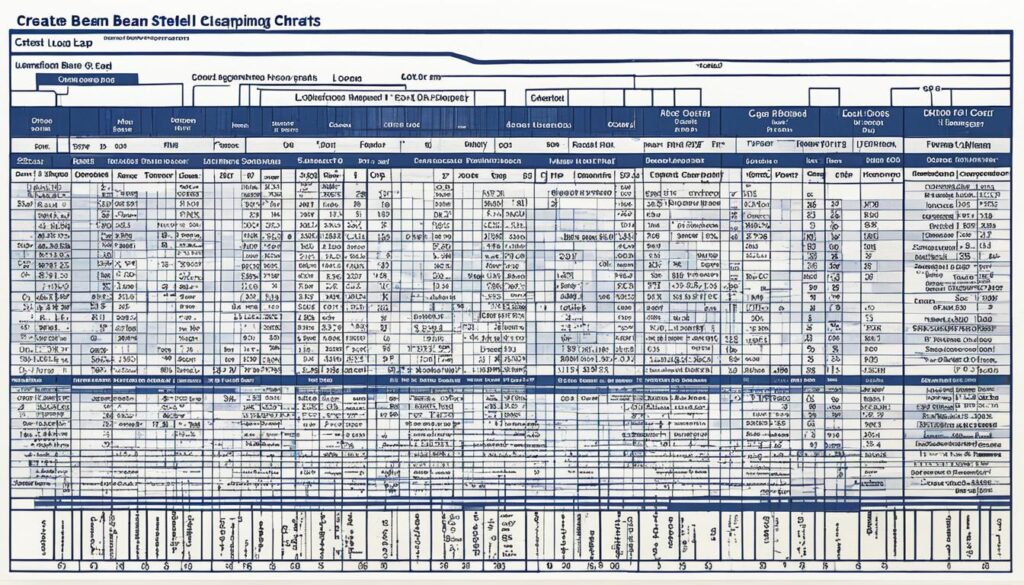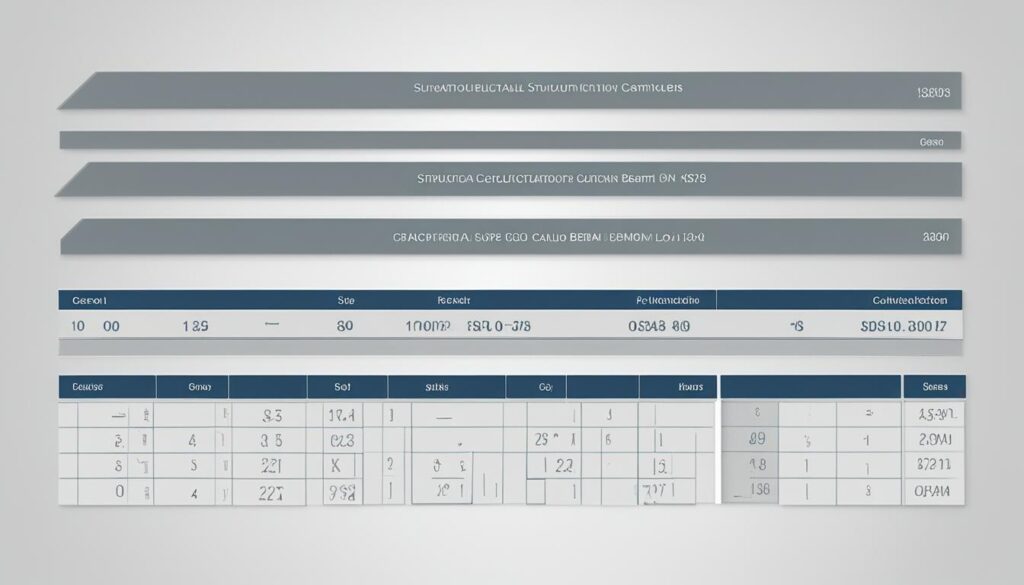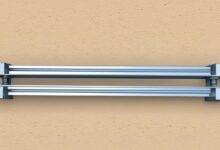Load Bearing Beam Size Chart
Load Bearing Beam Size Chart : Building a strong, dependable structure is key for any project. The load-bearing beam is a vital part

Load Bearing Beam Size Chart : Building a strong, dependable structure is key for any project. The load-bearing beam is a vital part that carries the building’s weight and keeps it stable. This guide offers a detailed load bearing beam size chart. It helps you pick the right beam size for your project, whether it’s wood, steel, or engineered beams. You’ll get all the specs and guidelines to make sure your structure is safe and meets building codes.

Key Takeaways
- Gain insight into the different types of load-bearing beams and their applications.
- Understand the factors that influence beam sizing, including span length and load capacity.
- Explore steel beam load capacity and wood beam span tables for residential and commercial projects.
- Learn how to use a structural beam sizing calculator to determine the optimal beam size for your needs.
- Familiarize yourself with building code requirements for load-bearing beams to ensure compliance.
Understanding Load Bearing Beams
Load bearing beams are key in building construction. They support the building’s weight and move it to the foundation. These beams vary in material and design, each with its own strengths and uses. Knowing about the different types is crucial for a building’s safety and strength.
What is a Load Bearing Beam?
A load bearing beam supports the floors, walls, and roof above it. It spans openings like doorways and windows, moving the load to the foundation. These beams are vital for keeping a building stable and preventing collapse.
Types of Load Bearing Beams
- Wood Beams: Wooden beams, like those from douglas fir, oak, or southern pine, are popular for homes and small businesses. They’re affordable, easy to work with, and can handle a good amount of weight.
- Steel Beams: Steel beams are used in big buildings because they’re strong and last a long time. They come in shapes like I-beams, H-beams, and channels, and can carry heavier loads than wood beams.
- Engineered Beams: Engineered beams, such as LVL or glulam, are made from layers of wood. They’re strong, consistent, and used in projects needing long spans or heavy loads.
Each beam type has its pros and cons, and the choice depends on the project’s size, space, and look. Knowing the strengths and considerations of each beam is key for a successful build.
Load Bearing Beam Size Chart
Choosing the right load bearing beam size is key for a project’s safety and strength. The load bearing beam size chart is a guide. It helps you pick the right beam size by considering span length, load capacity, and building codes.
This chart lists the best beam sizes for different load-bearing tasks. It’s a must-have for architects, engineers, and contractors. By using the load bearing beam size chart, you can pick the right beam for your project. This is true for any type of construction.
| Span Length (ft) | Beam Size (Nominal) | Beam Size (Actual) | Load Capacity (lbs/ft) |
|---|---|---|---|
| 8 | 2×8 | 1.5 x 7.25 | 400 |
| 10 | 2×10 | 1.5 x 9.25 | 500 |
| 12 | 2×12 | 1.5 x 11.25 | 600 |
| 14 | 2×14 | 1.5 x 13.25 | 700 |
| 16 | 2×16 | 1.5 x 15.25 | 800 |
The load bearing beam size chart is a key tool for ensuring your project is safe and meets building codes. By using this chart, you can design your project better. This ensures it lasts longer and is more reliable.
Factors Influencing Beam Sizing
Choosing the right load-bearing beam is crucial for your construction project. Several key factors must be considered to pick the right size and ensure your building is strong. The main factors are the beam’s span length and load capacity.
Span Length
The span length is how far the beam stretches between its supports. A longer span means you need a bigger, stronger beam to hold everything up. Building codes set limits on how long a beam can be, depending on its material and design.
Load Capacity
The load capacity is the heaviest weight a beam can hold without breaking. It depends on the beam’s material, size, and design. Codes tell us the minimum load capacity needed for different structures and uses. This ensures the beam can handle the structure’s weight and any extra loads like people or machines.
Other things that affect beam sizing include how much it can bend and local building codes. Engineers and builders must think about these when picking the right beam size. This way, they meet the project’s needs and follow safety rules.
| Beam Material | Span Length | Load Capacity |
|---|---|---|
| Steel | 20-60 ft | 5,000-50,000 lbs |
| Wooden | 12-40 ft | 2,000-20,000 lbs |
| Concrete | 15-50 ft | 10,000-100,000 lbs |
Knowing these factors helps construction pros make smart choices. This ensures their projects are safe and strong.
Steel Beam Load Capacity
Understanding the load capacity of steel beams is key for construction projects. Steel beams are strong, durable, and versatile, making them great for carrying loads. We’ll look into how steel beams handle loads and what to consider when choosing the right one for your project.
Steel beam load capacity shows how much weight or force a beam can hold without breaking. It depends on the beam’s size, material, and the loads it faces.
The steel beam load ratings are crucial. They tell us the highest stress a beam can take before it starts to bend or break. For big projects, knowing these ratings is vital.
| Beam Type | Typical Load Capacity (PSI) | Typical Load Capacity (kPa) |
|---|---|---|
| W8x10 Steel Beam | 36,000 PSI | 248 kPa |
| W12x16 Steel Beam | 50,000 PSI | 345 kPa |
| W16x26 Steel Beam | 55,000 PSI | 379 kPa |
When picking a steel beam, think about how much load it needs to carry. Consider the beam’s length, the weight of the structure, and any extra loads. These factors help decide the right size and strength of the beam.
Knowing about steel beam load capacity and ratings helps you make smart choices for your project. Talking to experts or using online tools can also help pick the best steel beam for your needs.

Wood Beam Span Tables
Understanding the maximum span of wood beams is key for load-bearing construction. Whether for a home or a business, knowing the right span lengths is crucial. It helps ensure your project’s structure is strong and safe.
Residential Wood Beam Spans
Homeowners and contractors find wood beam span tables very helpful. They show the best beam sizes for different spans and loads. You’ll see maximum spans for beams like 2×4, 2×6, 2×8, 2×10, and 2×12 in various woods.
Looking at the residential wood beam spans table helps pick the right beam size. It’s key for designing homes, adding rooms, or making changes. This ensures your home is safe and stands the test of time.
Commercial Wood Beam Spans
Commercial projects need commercial wood beam spans tables too. They help with the heavy loads and long spans found in big buildings. These tables help architects and builders pick the right wood beam load capacity for their projects.
Working on a store, office, or factory? The commercial wood beam span tables ensure your design meets safety and code standards.
“Proper beam selection is essential for the structural integrity and safety of any building, whether it’s a cozy home or a towering commercial structure.”
Using these detailed wood beam span tables helps make smart choices. These choices are key to your project’s success and lasting value.
Structural Beam Sizing Calculator
Finding the right size for load-bearing beams is key in building projects. Luckily, there’s a great tool to help: the structural beam sizing calculator. This tool lets you enter important details and quickly find the best beam size for your project.
How to Use a Beam Sizing Calculator
Using a structural beam sizing calculator is easy. Here’s what you do:
- Enter the beam’s span length, which is the distance from one support to the other.
- Choose the material, like steel or wood, for the beam.
- State the load capacity needed, considering the weight the beam will carry.
- Pick a safety factor, which covers any extra load or strength variations.
- The calculator will then give you the recommended beam size, making sure it’s safe and meets codes.
With a structural beam sizing calculator, you can trust your beams will handle the load well. This makes a strong and reliable base for your project.
“A well-designed structural beam is the cornerstone of any building’s integrity.”
For any project, big or small, a beam sizing tool is crucial. It helps with precise beam size calculation and ensures you follow the rules.

Using a structural beam sizing calculator makes designing easier, saves time, and builds safe, strong structures.
Building Code Beam Requirements
Building a structure requires strong load-bearing beams for safety. Codes and regulations set the rules for these beams. We’ll look at what’s needed for beam size, load, and how much it can bend.
Beam Size and Specification Guidelines
Codes say how big and what kind of beams to use based on the span and the loads they’ll carry. Beam specification guidelines help keep buildings stable and safe.
Beam Load Capacity and Deflection Limits
Codes also set limits on how much weight beams can hold and how much they can bend. These rules stop beams from sagging too much. Builders must pick beams that can handle the expected loads and meet the bending limits.
“The building code is the foundation for ensuring the structural integrity and safety of load-bearing beams in any construction project. Adhering to these regulations is essential for the well-being of the occupants and the longevity of the building.”
Knowing and following building code beam requirements helps builders make safe and lasting structures. Keeping up with code changes is key for a project’s success.
In short, the building code has rules for beam size, strength, and bending limits. These rules keep buildings safe and strong. Builders must follow these rules closely during design and building.
Conclusion :
In this guide, we’ve shared a detailed load bearing beam size chart and tips to help you pick the right beam size for your project. We covered how span length and load capacity affect beam size, along with important building codes. This knowledge ensures your project is safe and strong.
Whether it’s a home or a business, this article gives you the confidence to handle beam sizing. Using the beam sizing guidelines and a structural beam sizing calculator will help you design and build better load bearing beams. This leads to a successful construction project.
Starting your next building project? Remember, the load bearing beam size chart and the info here are key to making good choices. Using this knowledge boosts your project’s strength and safety. It also makes your building last longer.
FAQ
What is a load bearing beam?
A load bearing beam is a key part of a building’s structure. It carries the weight of the roof, walls, floors, and more. This includes furniture, people, and equipment too.
What are the different types of load bearing beams?
Common types include wood beams, steel beams, and engineered beams like I-beams and laminated veneer lumber.
How do I determine the appropriate size for a load bearing beam?
Choosing the right size depends on the span length, load capacity, and building codes. A load bearing beam size chart can guide you in picking the correct size for your project.
What is the maximum allowable deflection for a load bearing beam?
The maximum deflection allowed varies by building code. Generally, it should not exceed L/360 of the span length, where L is the span.
How do I use a structural beam sizing calculator?
For a structural beam sizing calculator, enter the span length, load capacity, and building code needs. It will suggest the right beam size and specs for safety and strength.
What are the building code requirements for load bearing beams?
Codes set minimum size, load capacity, and deflection limits. They depend on the construction type and building use. Always check your local codes to ensure your beam meets all standards.
How do I determine the load capacity of a steel beam?
The load capacity of a steel beam depends on its size, shape, and material. Use steel beam load ratings and capacity charts to pick the right size for your project.
What are the maximum span lengths for wood beams?
Wood beam span tables outline the max span lengths for different beam sizes, species, and loads. These are useful for both home and commercial projects.




